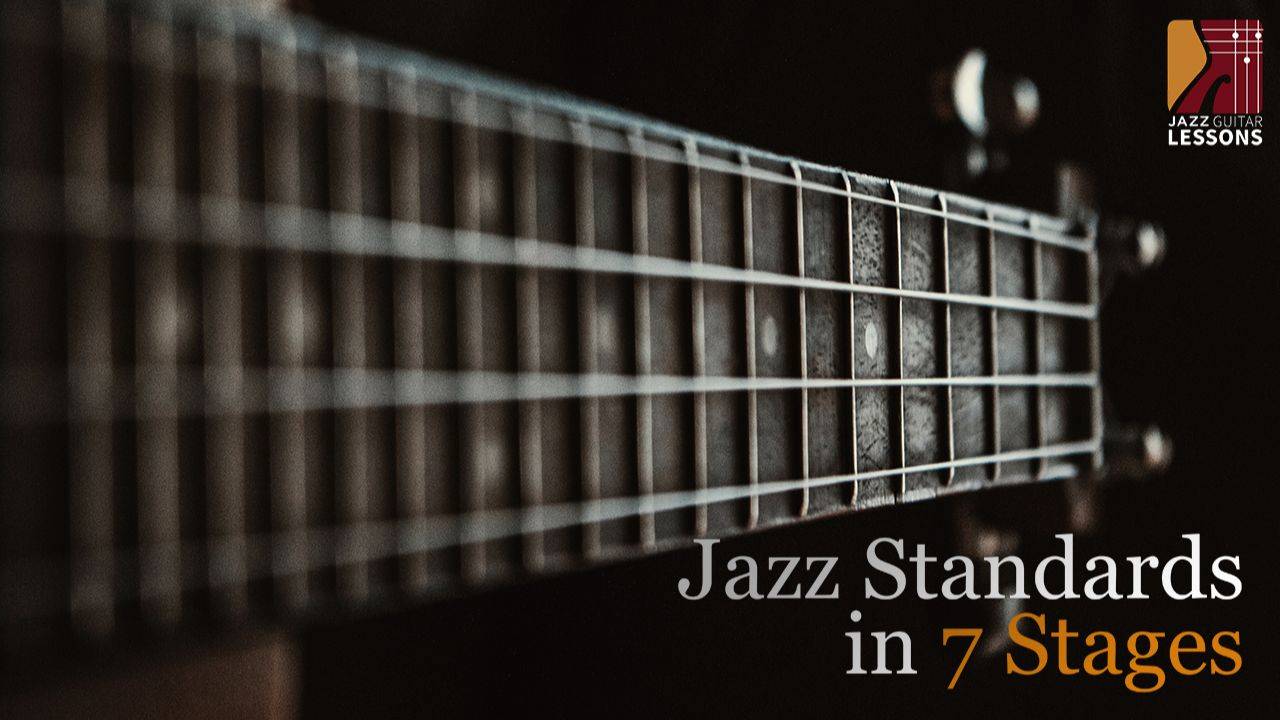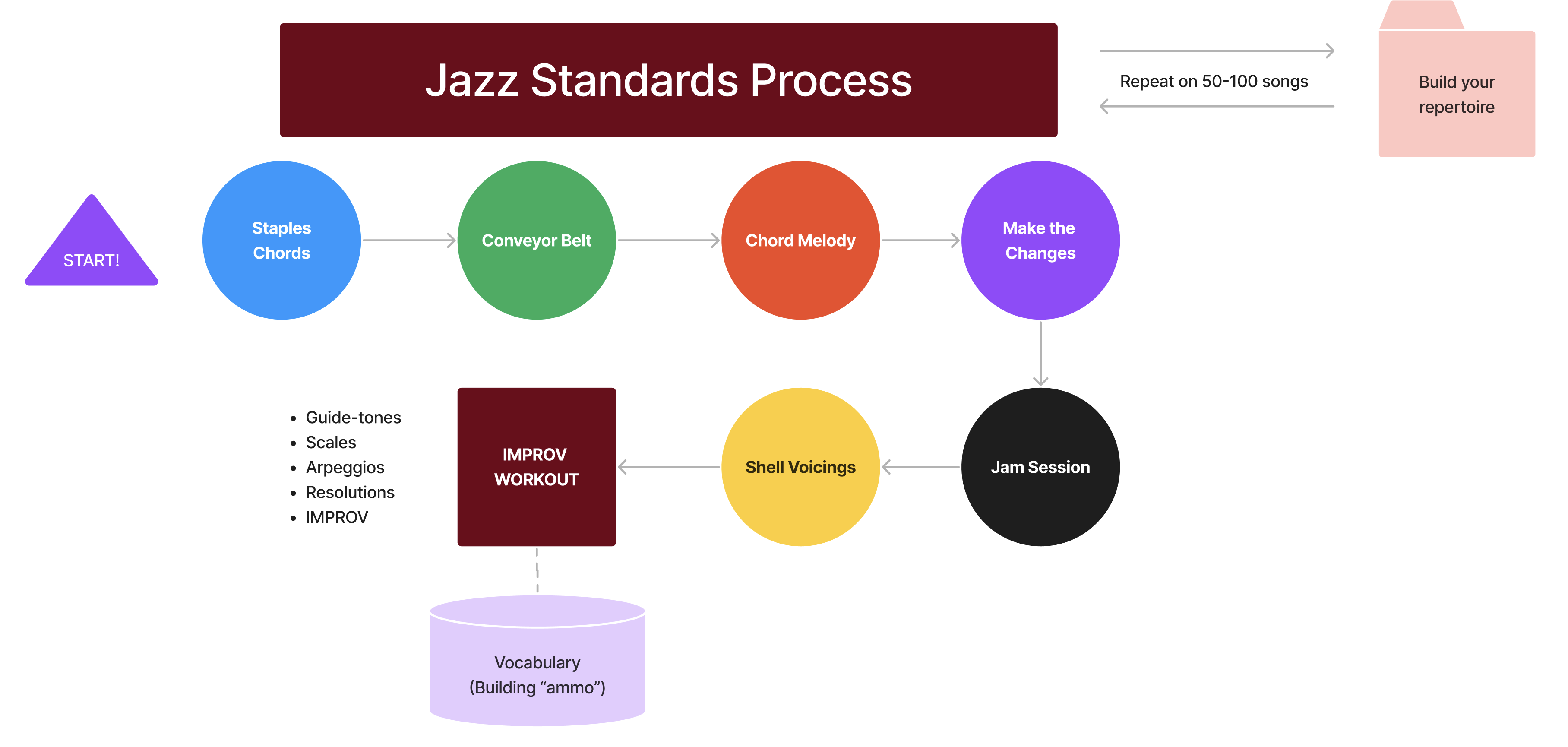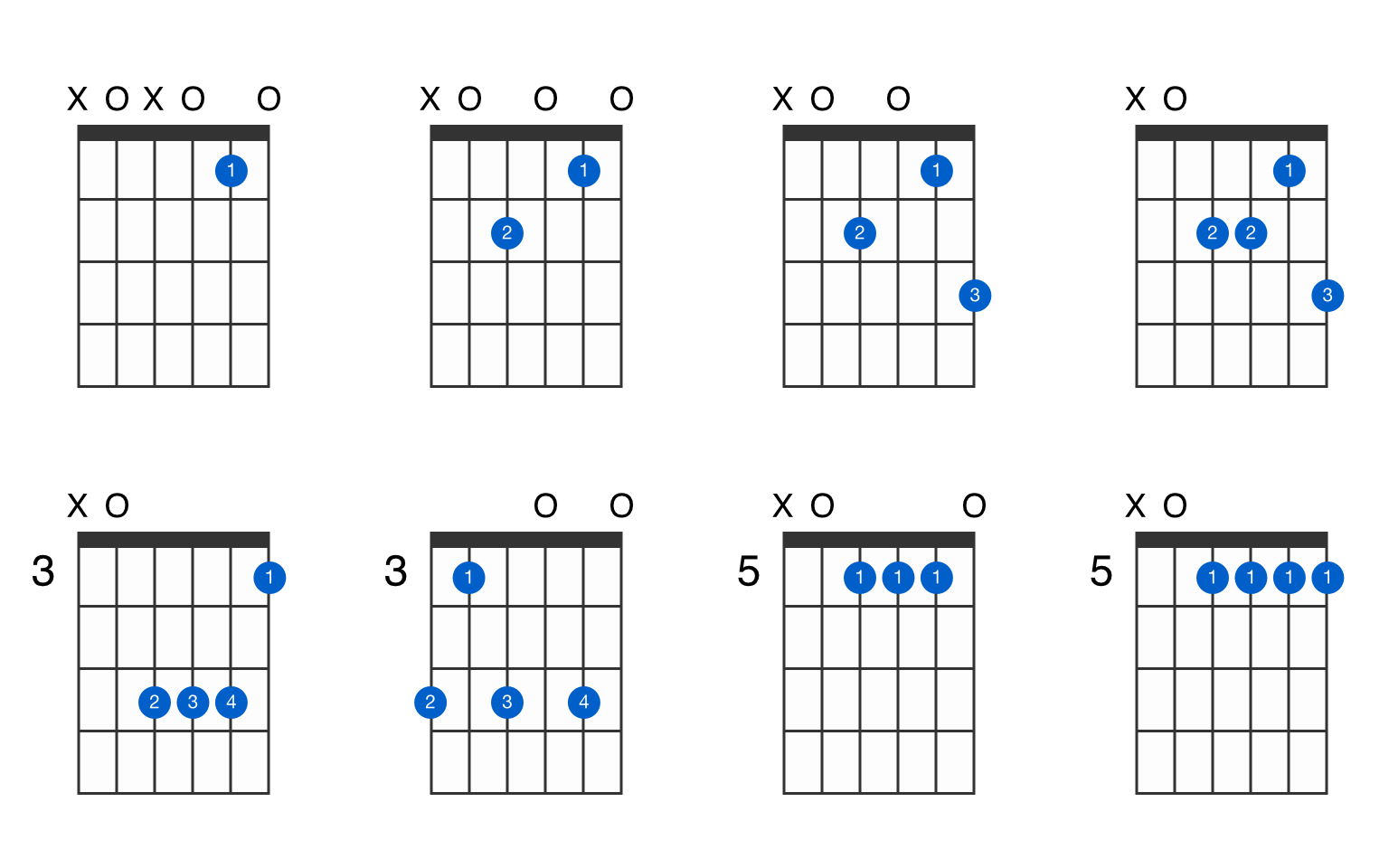
Teach Yourself Jazz Standards on Guitar: 7-Stage Process
Feb 01, 2023Introduction
Learning jazz standards can seem daunting for many musicians, but it doesn't have to be! In this blog post, let's walk you through a replicable process that you can use to learn any jazz standard that my students and I have used. This means that this process has been proven and tested! Isn't that great?
Whether you're a beginner or a more experienced player, this process will help you to dive deeper into the realm of jazz and gain a much better understanding of how these tunes came to be. While it can be challenging for musicians of all skill levels, studying these beautiful jazz standards is worthwhile as it helps to develop musicianship and deepen one's understanding of jazz music.
By following these steps, you can learn any jazz standard on your own and develop your jazz guitar skills further. So... without further ado, let's get to the main course.
Check out the full video lessons YouTube playlist HERE

Stage Zero: Pick the Tune
Choosing the perfect piece to play is a vital part of any musician's journey, especially when it comes to jazz standards. Start by picking a tune that captures your interest and passion; be it a timeless classic like "Autumn Leaves" or "Summertime," or a contemporary hit like "Blue Bossa." The most important thing is to choose a tune that you'll have a blast playing and that will challenge you to get even better.
Once you've found your tune, grab a lead sheet or chord chart to use as a guide. Lead sheets provide a simplified version of the song, including the melody and chord progression, while chord charts offer a visual representation of the chords and their positions on the guitar. Both options are fantastic starting points for learning a new tune and can be easily found online on our website or in jazz guitar books.
Stage One: Find Easy Voicings
The next step is to find voicings that are easy for you to play with. This means finding guitar chords or chord shapes that you're comfortable with and that sound good to you. For example, if the first chord in the tune is an A minor chord, you might find an Am7 chord shape that you like.

As you work through the tune, make sure to find voicings for each chord that are easy for you to play. It's also important to take into account the context of the song and the style of music you are playing to make sure the voicings you choose are appropriate. In this step, you don't have to focus on playing on time yet and give attention to the voicings you will want to play.
Stage Two: Add Time
Once you have found voicings for the chords in a tune that are easy for you to play and that sound good to you, the next step is to add time. This means playing the voicings in a consistent and steady rhythm, in time with a metronome, a backing track, or a live musician or drummer. The metronome or backing track can provide a consistent tempo and beat to help you stay in time as you practice. Playing in time with the beat is crucial for making the tune sound polished and professional. To help stay in time, it's helpful to count out loud as you play -- for example, saying "1-2-3-4" as you play through the tune. It is important to practice this step until you can play the tune comfortably and in time without any external help. Additionally, it's also important to practice playing with dynamics and phrasing which can add more emotion to the tune.

Learn more about playing in time: Time is of the Essence and What to Do About it
Stage Three: Build a Chord Melody
The third step is to build a chord melody arrangement of the tune. This means taking the melody and adding chords to it to create a harmonized version of the tune. There are different ways to build a chord melody arrangement: you can find chord melody arrangements online, in jazz guitar books or you even can create your own! When creating your own chord melody arrangement, it's important to consider the melody, harmony, and rhythm of the tune, and to experiment with different chords and voicings to find the best fit. The goal is to develop your own version of the tune that you can play and improvise on, and that sounds good to your ear. Creating your own chord melody arrangement allows you to personalize the tune and make it your own.
If you want to learn the basics of building a chord melody, you can check out this blog post before continuing: How To Build A Chord Melody in 3 Easy Steps
Stage Four: Making the Changes
In the fourth stage, start to make changes in your improvisation by picking up some vocabulary. This can include learning arpeggios, chords, and scales – but a simple and effective approach is to focus on the third degree of each chord. ;)
To do this, analyze the third degree of each chord in a song and resolve into it from above with one note. This approach will help you make the changes in any song and you'll notice that if you've done your job well the first step after you pick the song typically your chords will include the third degree in it. This is just a start to get you making the changes and building a reliable tool that you can use to improvise on any song.
Stage Five: Jam Session
In the fifth stage of my jazz guitar learning process, we move from studying the theory and mechanics of playing to actually putting it into practice! The best way to do this is by participating in jam sessions, where you can learn from other musicians and apply what you've learned in a real-life setting. To make this process more accessible, you can also use tools like iReal Pro and YouTube to find backing tracks for songs like "Autumn Leaves" in your desired key.
Now you have something to play along to, here are some things you can do:
- Melody
- Only play the naked melody of the tune without the chords. This can give you more familiarity with the tune and see how you do with backing tracks or other musicians.
- Comping
- Use the voicings with a good rhythm that you have learned and play only naked comping. This is also very important in jams, especially when letting other musicians play the melody.
- Solo/Improvise
- Now, with all your knowledge of jazz guitar and within the context of the tune, you can try improvising with the phrasing vocabulary that you know. For me, this is the most fun as this is where you can express freely and converse the most with the music that surrounds you!

Stage Six: Shell Voicings
In the sixth stage, you'll take the voicings you've learned in the first stage and start to experiment with them. You'll remove some of the bass notes, also called "rootless voicings," and add in sharp 9s, flat 9s, and sharp 5s, creating more complex and interesting voicings. This stage is about developing your own unique style and approach to playing jazz guitar.
Shells are great! With these, you can outline these voicings without drowning them with the lower register of your guitar. On jam sessions, you can let the bass players handle the bass part :)
Here is a good introduction to the shell voicings to get started: How to Play Shell Voicings for Jazz Guitar (3-Note Chords)
Stage Seven: Improv Workout
You've made it to the seventh stage! This is where the real fun begins - you get to bring everything you've learned so far. In this stage, you'll discover how all the different parts of jazz guitar blend together and develop the power to create your own solos on the spot. It's also really flexible, so you can mold it to your own desires and needs. In this workout, you can create exercises such as doing scales, guide tones, or arpeggios for parts of the tune. Build your vocabulary for the tune to the point where you can be comfortable with these different aspects, and in the end, improvise. The purpose of this step isn't just to make you do certain exercises, but to provide you with a reliable, repeatable system you can use to master multiple songs and constantly improve your skills. Get ready to show off your skills!
Conclusion
In summary, learning jazz standards can be a rewarding and challenging process, but by following this simple seven-step process, you can break it down into manageable pieces. And remember: don't hesitate to use any resource available to you as these can help you learn and achieve your goals faster. Now, I hope that with these steps, you can start learning the tunes that you have wanted to learn by yourself. Cheers!









